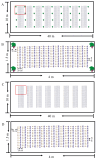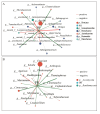Effects of saffron-grape intercropping on saffron flower number and rhizosphere microbial community
- PMID: 39736513
- PMCID: PMC11684302
- DOI: 10.1186/s12866-024-03716-4
Effects of saffron-grape intercropping on saffron flower number and rhizosphere microbial community
Abstract
Background: Saffron (Crocus sativus L.) is a valuable herb. With the increasing demand for saffron, people are starting to focus on how to increase its yields. Intercropping and microbial interactions have a positive effect on plant yield, including enhanced soil fertility, enriched microbial diversity, reduced pest and disease incidences, and improved plant growth. However, the impact of intercropping saffron with other plants on saffron yields and soil microbial community diversity remains unclear. In our study, we counted the number of saffron flowers in two cropping patterns (saffron monoculture and saffron-grape intercropping), and analyzed the microbial community diversity and composition using Illumina high-throughput sequencing methods based on 16 S and ITS amplicons.
Results: The results showed that saffron-grape intercropping significantly increased number of flowers compared to saffron monoculture (P < 0.01). Saffron-grape intercropping influenced rhizosphere soil chemical properties and altered rhizosphere microbial communities. The pH of intercropped rhizosphere soil increased significantly from 5.84 to 6.43. Spearman's correlation revealed a significantly positive correlation between pH and Bacillus, Sphingomonas, Sphingobacterium, Halomonas, Pseudolabrys, and Dongia. Conversely, it showed a significant negative correlation with Pedobacter, Achromobacter, Tumebacillus, and Sphingopyxis in bacteria. In fungi, a significant negative correlation was observed. Although there was no significant difference in diversity, intercropping increased the observed richness and biodiversity of both bacteria and fungi compared to monoculture. The intercropping led to a higher relative abundance of bacterial genera such as Sphingomonas and Streptomyces, as well as fungal genera including Acremonium, Llyonectria, Penicillium, Cadophora, Plectosphaerella, and Tetracladium. Intercropping decreased the dominance of certain microbial taxa, including Fictibacillus, Microbacterium, and Glutamicibacter among bacterial genera, as well as Fusarium and Arthrographis among fungal genera. Additionally, functional analysis revealed that intercropping was significantly higher (P < 0.01) than monoculture in dark hydrogen oxidation, denitrification, nitrate denitrification, nitrous oxide denitrification, nitrite denitrification, and manganese oxidation. Plant pathogens decreased from 6.13% in monoculture to 2.46% in intercropping.
Conclusion: This study found that saffron-grape intercropping positively affected saffron yield. Based on the existing data, intercropping resulted in an increase in microbial communities, including some taxa previously identified as beneficial for other plants. These findings establish the foundation for the widespread application of saffron-grape intercropping and offer a promising strategy for increasing saffron yield.
Keywords: Flower number; Functional prediction; Microbial community; Rhizosphere soil; Saffron-grape intercropping.
© 2024. The Author(s).
Conflict of interest statement
Declarations. Ethics approval and consent to participate: Not applicable. Consent for publication: Not applicable. Competing interests: The authors declare no competing interests. Statement: The sampling was conducted in holder farmer land and permission has been obtained from them to sample at this land.
Figures









Similar articles
-
Potato-onion intercropping enhances tomato yield and quality and modifies soil microbial diversity.Sci Rep. 2025 Aug 20;15(1):30573. doi: 10.1038/s41598-025-15045-1. Sci Rep. 2025. PMID: 40835993 Free PMC article.
-
Responses of rhizosphere bacterial communities with different niche breadths to liquid fertilizer produced from Fuji apple wastes during planting process.Microbiol Spectr. 2025 Jul;13(7):e0206824. doi: 10.1128/spectrum.02068-24. Epub 2025 May 30. Microbiol Spectr. 2025. PMID: 40445252 Free PMC article.
-
Characteristics and Influencing Factors of Rhizosphere Microbial Communities of Tuber himalayense-Corylus heterophylla Ectomycorrhizosphere.Pol J Microbiol. 2025 Jun 18;74(2):177-191. doi: 10.33073/pjm-2025-015. eCollection 2025 Jun 1. Pol J Microbiol. 2025. PMID: 40544518 Free PMC article.
-
Systemic pharmacological treatments for chronic plaque psoriasis: a network meta-analysis.Cochrane Database Syst Rev. 2021 Apr 19;4(4):CD011535. doi: 10.1002/14651858.CD011535.pub4. Cochrane Database Syst Rev. 2021. Update in: Cochrane Database Syst Rev. 2022 May 23;5:CD011535. doi: 10.1002/14651858.CD011535.pub5. PMID: 33871055 Free PMC article. Updated.
-
Systemic pharmacological treatments for chronic plaque psoriasis: a network meta-analysis.Cochrane Database Syst Rev. 2017 Dec 22;12(12):CD011535. doi: 10.1002/14651858.CD011535.pub2. Cochrane Database Syst Rev. 2017. Update in: Cochrane Database Syst Rev. 2020 Jan 9;1:CD011535. doi: 10.1002/14651858.CD011535.pub3. PMID: 29271481 Free PMC article. Updated.
Cited by
-
Correlation analysis between quality characteristics and rhizosphere microorganisms of different wine grape varieties during their ripening phase.Front Microbiol. 2025 Mar 26;16:1546323. doi: 10.3389/fmicb.2025.1546323. eCollection 2025. Front Microbiol. 2025. PMID: 40207156 Free PMC article.
References
-
- Melnyk JP, Wang S, Marcone MF. Chemical and biological properties of the world’s most expensive spice: saffron. Food Res Int. 2010;43(8):1981–9.
-
- Gupta V, Sharma A, Rai PK, Gupta SK, Singh B, Sharma SK et al. Corm rot of saffron: epidemiology and management. Agronomy. 2021.
-
- Kafi M, Kamili AN, Husaini AM, Ozturk M, Altay V. An expensive spice saffron (Crocus sativus L.): a case study from Kashmir, Iran, and Turkey. Global perspectives on underutilized crops. 2018:109–49.
-
- Kothari D, Thakur R, Kumar R. Saffron (Crocus sativus L.): gold of the spices—a comprehensive review. Hortic Environ Biotechnol. 2021;62(5):661–77.
MeSH terms
Substances
Grants and funding
LinkOut - more resources
Full Text Sources

